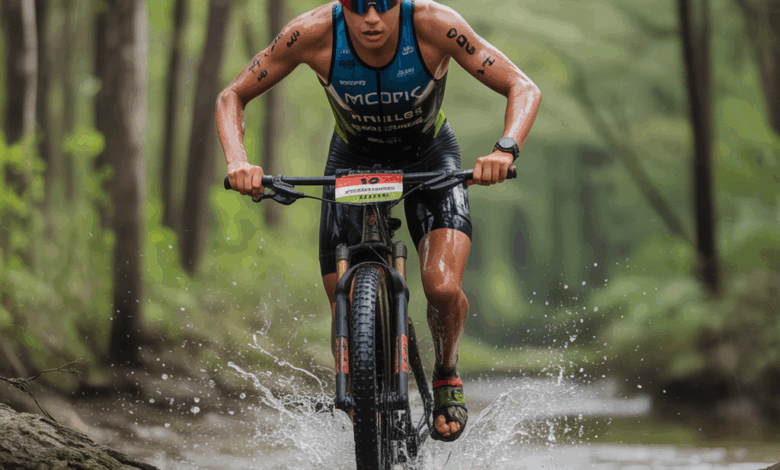Xterra Triathlon Adventure Racing

Ever imagined trading a flat road for a muddy singletrack, a calm pool for a choppy lake, and a smooth bike course for a rocky descent? If that thought makes your heart race, then xterra triathlon adventure racing might be your next epic challenge. Whether you’re a road triathlete looking to go off-road or a trail runner craving new terrain, this guide breaks down training, gear, and race-day strategy so you can cross that finish line with a grin (and minimal mud in your shoes).
What Is xterra triathlon adventure racing?
XTERRA-style events—often called cross triathlons or off-road triathlons—combine open-water swimming, mountain biking, and trail running. Unlike traditional triathlons, courses are technical: expect rocky descents, steep climbs, tight singletrack, and unpredictable weather. This type of adventure racing tests endurance, bike-handling skills, and adaptability.
Why athletes love off-road triathlons
- Variety: Different terrain keeps training fun and mentally engaging.
- Technical challenge: Mountain biking skills and trail running technique matter as much as aerobic fitness.
- Scenic courses: Many races are set in beautiful, remote locations.
Training Essentials for xterra triathlon adventure racing
Adventure racing training is a mix of endurance, strength, technical skill work, and race-specific practice. Here’s how to structure a balanced plan.
1. Base endurance: swim, bike, run
- Swim: Focus on open-water sessions—sighting, mass-start practice, and drafting. If you can’t access open water every week, do one open-water session and repeat lake-simulation drills in the pool.
- Bike: Build aerobic hours on the mountain bike (or gravel bike if MTB access is limited). Include long rides with sustained climbs to mimic race demands.
- Run: Trail runs should simulate race terrain—rooty, rocky, and hilly. Work on downhill technique and controlled braking techniques to save quads for the finish.
2. Intensity and intervals
Incorporate one interval session per sport weekly:
- Swim intervals: 6–8 x 200m at threshold pace with 20–30s rest.
- Bike VO2 max: 5 x 3–5 minutes hard on climbs with 3–5 minutes recovery.
- Run hill repeats: 8 x 60–90s uphill at hard effort, jog down recovery.
3. Technical skill sessions
Spend time on skills that matter in off-road triathlon:
- Cornering, bunny hops, and line choice on singletrack.
- Open-water sighting and handling chop.
- Practice transitions on uneven ground and in wet shoes to simulate race conditions.
4. Strength, mobility, and injury prevention
Two full-body strength sessions per week—focus on single-leg strength, core stability, and posterior chain (deadlifts, split squats, single-leg RDLs). Add dynamic mobility (hip openers, thoracic rotation) to handle technical terrain and reduce injuries.
Sample Week: Off-Road Triathlon Training Plan
- Monday: Recovery swim + mobility (45–60 min)
- Tuesday: Interval bike on local climbs + short trail run (brick) (90–120 min)
- Wednesday: Strength session + easy pool swim (60–75 min)
- Thursday: Hill repeat trail run (60 min) + easy spin (30 min)
- Friday: Skills-focused mountain bike session (90 min)
- Saturday: Long off-road ride with sustained climbs (3–4 hrs)
- Sunday: Long trail run or race simulation (1.5–2.5 hrs)
Gear & Nutrition Tips for Adventure Racing
Must-have gear
- Hardtail mountain bike or reliable full-suspension if the course is very technical.
- Fast-rolling, puncture-resistant tires with appropriate tread for mixed terrain.
- Trail running shoes with good grip and drainage; consider gaiters for mud.
- Wetsuit suited for local water temps, open-water goggles, and anti-chafe lubricant.
- Compact multi-tool, spare tube/CO2, lightweight hydration pack for nutrition and tools.
Race-day fueling strategies
Practice race nutrition during long rides and runs. A good starting point:
- Use carbohydrates at 30–60 g/hour for shorter events, up to 90 g/hour for longer races.
- Combine gels, chews, and real-food options (bananas, small sandwiches) based on what your stomach tolerates.
- Drink electrolyte-rich fluids to avoid cramps—especially important in hot, muddy, or humid conditions.
xterra triathlon adventure racing: Race Strategy & Pacing
Go in with a plan but be ready to adapt. Technical sections might require dismounting—accept the time loss if it saves you a crash. Key race strategies include:
- Swim conservatively in the chaos of the start; position yourself to avoid the main bottle-neck.
- On the bike, pace big climbs and recover on easier sections. Technical descents reward skill more than raw power.
- Run by feel—don’t blow up early on tricky downhills. Break the course into segments for mental focus.
Real-world example
Jess, a former road triathlete, switched to off-road triathlons and shaved 20 minutes off her first XTERRA race in a season by adding two weekly skill sessions, switching to a hardtail MTB, and mastering downhill braking. Small, focused changes yield big race-day improvements.
Common Mistakes to Avoid
- Only training on roads—technical skills are non-negotiable for off-road success.
- Overpacking on race day—extra weight and clumsy gear cost time and energy.
- Neglecting recovery—hard trails and mountain biking demand more soft-tissue recovery than flat road work.
Frequently Asked Questions
1. How do I transition from road triathlon to xterra triathlon adventure racing?
Start by adding technical mountain bike sessions and trail runs once or twice a week. Practice open-water swims and brick workouts that pair MTB and trail running. Gradually replace some road volume with off-road sessions and invest time in skills—cornering, line choice, and descending.
2. What kind of bike is best for XTERRA-style races?
A hardtail mountain bike is the most versatile and low-maintenance option for many courses. Choose tire width and tread appropriate for the terrain—knobbies for loose dirt, semi-slicks for mixed conditions. Full suspension can help on very technical or rocky courses, but adds weight and complexity.
3. How should I handle nutrition on a muddy, cold race day?
Cold and muddy conditions can blunt thirst signals and make gels hard to unwrap. Use pre-measured bottles or chews, and carry a short, ready-to-eat calorie source like a gel or an energy bar in an accessible pocket. Layer clothing to maintain core temperature and prioritize electrolytes and carbohydrates to sustain power.
Conclusion — Ready to Tackle xterra triathlon adventure racing?
Off-road triathlons are equal parts grit, skill, and strategy. With focused technical practice, structured endurance work, and a race-savvy nutrition plan, you’ll be ready to take on the mud, climbs, and singletrack. Start small—add one MTB skills session and one trail run this week—and build from there. Want detailed plans to match your level? Check out our workout routines and browse our nutrition guides to get a personalized race plan. For ongoing recovery and lifestyle habits, explore our wellness tips. Now get out there—trail, lake, and singletrack await.




